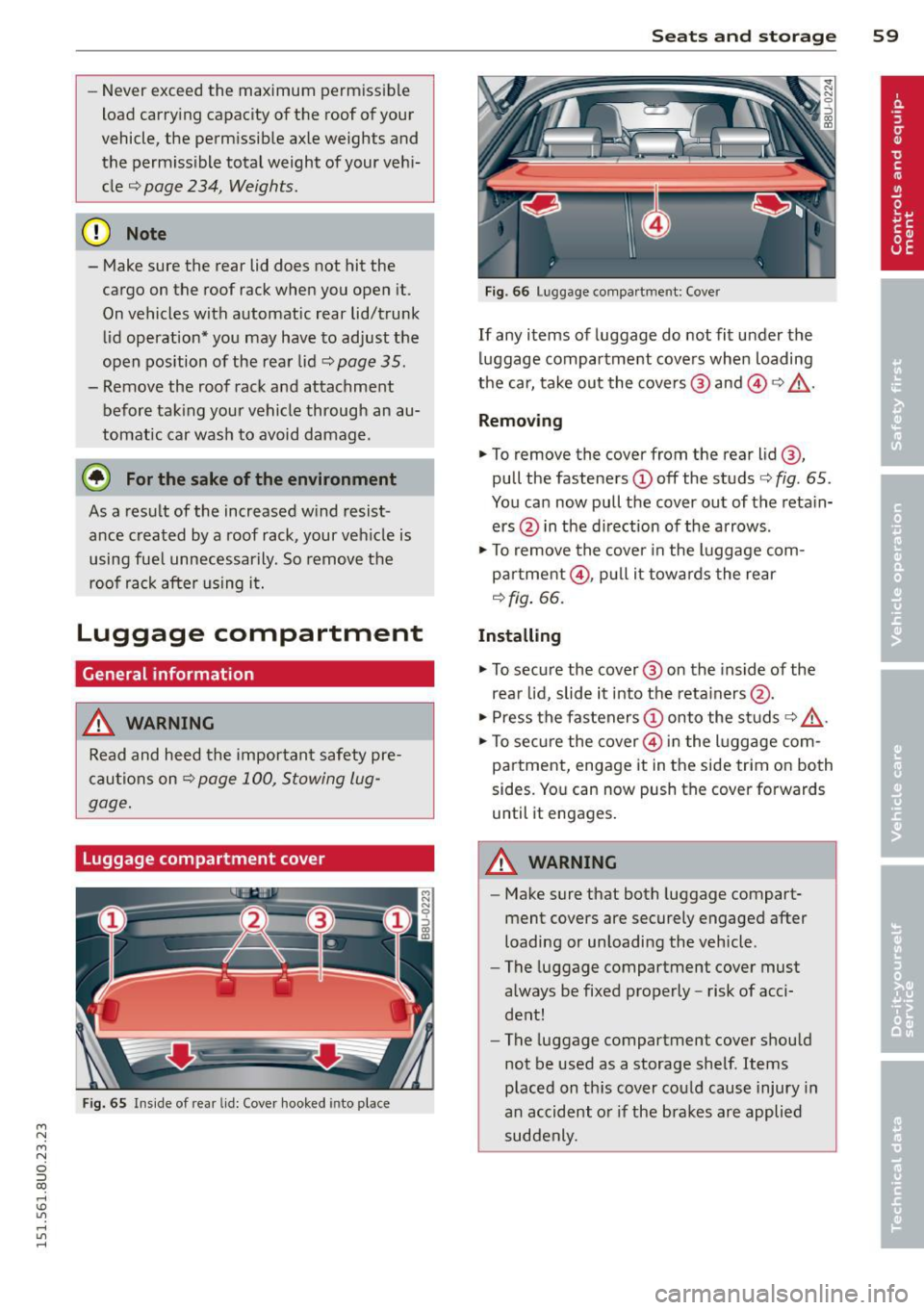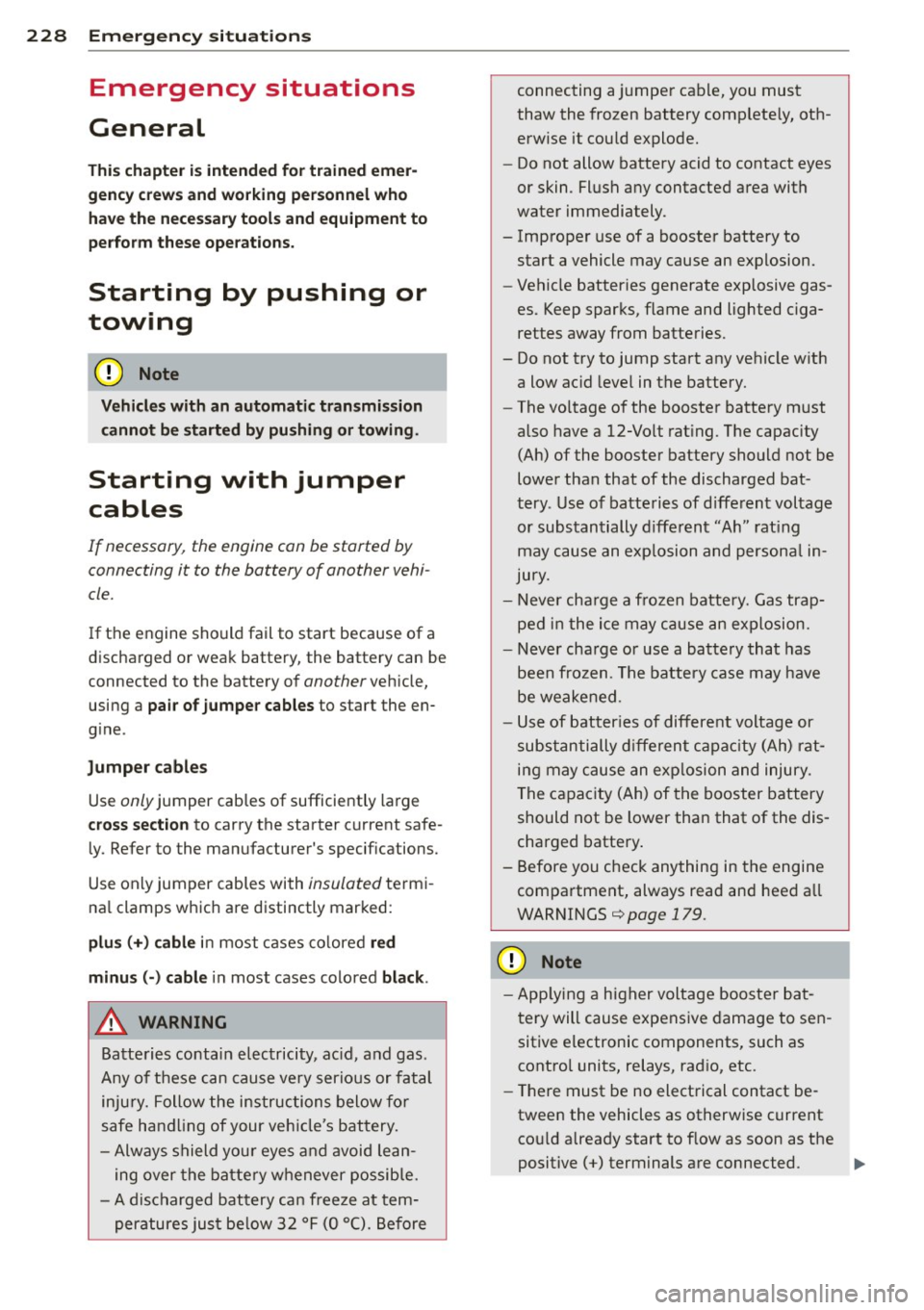towing capacity AUDI Q3 2015 Owners Manual
[x] Cancel search | Manufacturer: AUDI, Model Year: 2015, Model line: Q3, Model: AUDI Q3 2015Pages: 258, PDF Size: 64.9 MB
Page 61 of 258

M N M N
0 ::i co
rl I.O
"' rl
"' rl
-Never exceed the maximum permissible
load carry ing capacity of the roof of your
vehicle, the perm issible axle weights and
the permiss ible total weight of your veh i
cle ¢
page 234 , Weights .
(D Note
- Make sure the rear lid does not hit the
cargo on the roof rack when you open it.
On vehicles with automatic rear lid/trunk
lid operation* you may have to adjust the
open position of the rear lid
¢ page 35.
- Remove the roof rack and attachment
before taking your vehicle through an au
tomatic car wash to avoid damage .
@l For the sake of the environment
As a result of the increased w ind resist
ance created by a roof rack, your veh icle is
using fue l unnecessarily . So remove the
roof rack after using it.
Luggage compartment
General information
,& WARNING
Read and heed the importan t safety pre
cautions on ¢
page 100, Stowing lug
gage .
Luggage compartment cover
Fig. 65 Inside of re ar lid: Cove r hooked in to pl ace
-
S ea ts a nd s to rage 59
Fig. 66 Lug gage compa rtm en t: Co ver
If any items of luggage do not fit under the
luggage compartment covers when loading
the car, take out the covers @ and @¢,&. .
Remo ving
.,. To remove the cover from the rear lid@,
pull the fasteners
CD off the studs c:> fig. 65 .
You can now pull the cover ou t of the retain
ers @in the d irection of the arrows .
.,. To remove the cove r in the luggage com
p a rtment @, pu ll it towards the rear
¢ fig. 66.
Installing
.,. To secure the cover @ on the inside of the
rea r lid, slide it into the reta iners @.
.,. Press the fasteners
CD onto the studs¢,&. .
.,. To sec ure the cover @ in the luggage com
partment, engage it in the side trim on both
sides. You can now push the cover forwards
until it engages.
,& WARNING
- Make sure that both luggage compart
ment covers are securely engaged after
loading or unloading the vehicle .
- The luggage compartment cover must
always be fixed properly -risk of acci
dent!
- The luggage compartment cover shou ld
not be used as a storage shelf. Items
placed on th is cover could cause injury in
an accident o r if the bra kes are applied
suddenly.
-
Page 206 of 258

204 Tires and wheels
-Always make sure that the total load be
ing transported -including the weight of
a trailer hitch and the tongue weight of a
loaded trailer -does not make the vehi
cle heavier than the vehicle's Gross Vehi
cle Weight Rating.
Determining correct load limit
Use the example below to cal
culate the total weight of the
passengers and luggage or oth
er things that you plan to trans
port so that you can make sure
that your vehicle will not be
overloaded.
Steps for Determining
Correct Load Limit
1. Locate the statement "THE
COMBINED WEIGHT OF OC
CUPANTS AND CARGO
SHOULD NEVER EXCEED XXX
KG OR XXX LBS"on your vehi
cle's placard (tire inflation pressure label)
¢ page 199,
fig. 152.
2. Determine the combined
weight of the driver and pas sengers that will be riding in
your vehicle.
3. Subtract the combined
weight of the driver and pas sengers from
"XXX" kilo
grams or
"XXX" pounds shown on the sticker
r:=> page 199, fig. 152.
4. The resulting figure equals
the available amount of car
go and luggage load capaci
ty. For example, if the
"XXX"
amount equals 1400 lbs.
and there will be five
150
lbs. passengers in your vehi
cle, the amount of available
cargo and luggage load ca
pacity is
650 lbs. (1400-7 50
(5
X 150) = 650 lbs.)
5. Determine the combined
weight of luggage and cargo being loaded on the vehicle.
That weight may not safely
exceed the available cargo
and luggage load capacity
calculated in Step
4.
6.
If your vehicle will be towing
a trailer, load from your trail
er will be transferred to your
vehicle. Consult this manual
to determine how this re duces the available cargo
and luggage load capacity of
your vehicle.
... Check the tire sidewall
(¢ page 206, fig. 156) to de
termine the designated load rating for a specific tire.
Page 230 of 258

228 Emergency situations
Emergency situations
General
This chapter is intended for trained emer
gency crews and working personnel who
have the necessary tools and equipment to
perform these ope rations.
Starting by pushing or
towing
Q;) Note
Vehicles with an automati c transmission
cannot be started by pushing or towing .
Starting with jumper
cables
If necessary, the engine can be started by
connecting it to the battery of another vehi
cle.
If the engine should fail to start because of a
discharged or weak battery, the battery can be
connected to the battery of
another veh icle,
using a
pair of jumper cables to start the en
g ine .
Jumper cables
Use only jumper cables of sufficiently large
cross section to carry the starter current safe
ly. Refer to the manufacturer's specifications.
Use only jumper cables with
insulated termi
na l clamps which are distinctly marked:
plus(+) cable in most cases colored red
minu s(-) cable
in most cases colored black .
A WARNING
Batteries contain electricity, ac id, and gas .
Any of these can cause very serious or fatal
inju ry. Follow the instructions below for
safe handling of your veh icle's battery.
- Always shield you r eyes and avoid lean
ing over the battery whenever possible.
- A discharged battery can freeze at tem
peratures just be low 32 °F (0 °C). Before connecting a
jumper cable, you must
thaw the frozen battery complete ly, oth
erwise it could explode.
- Do not allow battery acid to contact eyes
or skin . Flush any contacted area with
water immediately .
- Improper use of a booster battery to start a vehicle may cause an explosion.
- Vehicle batteries generate explosive gas
es. Keep sparks, flame and lighted ciga
rettes away from batteries.
- Do not try to jump start any vehicle with a low ac id level in the battery.
- The vo ltage of the booster battery must
also have a 12-Volt rating . The capacity
(Ah) of the booster battery should not be
lower than that of the discharged bat
tery . Use of batteries of d ifferent voltage
or substantially different "Ah" rating
may cause an exp losion and personal in
jury.
- Never charge a frozen batte ry. Gas trap
ped in the ice may cause an explosion.
- Never charge or use a battery that has
been frozen. The battery case may have
be weakened.
- Use of batter ies of different voltage or
substantially different capacity (Ah) rat
ing may cause an exp losion and injury.
The capacity (Ah) of the booster battery
should not be lower than that of the dis
charged battery.
- Before you check anything in the engine
compartment, always read and heed a ll
WARNINGS ¢
page 179.
(D Note
-App lying a higher voltage booster bat
tery will cause expensive damage to sen
sitive electronic components, such as
control units, relays, radio, etc .
- Th ere must be no electrical contact be
tween the vehicles as otherwise current cou ld already start to f low as soon as the
positive(+) terminals are connected. .,.